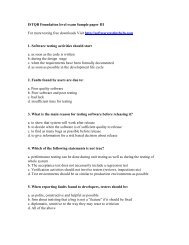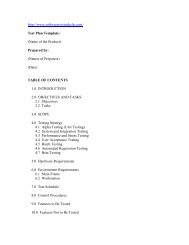CSTE Mock Test - Software Testing Help
CSTE Mock Test - Software Testing Help
CSTE Mock Test - Software Testing Help
You also want an ePaper? Increase the reach of your titles
YUMPU automatically turns print PDFs into web optimized ePapers that Google loves.
<strong>CSTE</strong> <strong>Mock</strong> <strong>Test</strong> - Part IV – Questions Along with Answers<br />
Note:<br />
• Answers provided in this sheet are all marked in blue.<br />
• Should be used as reference material for the <strong>CSTE</strong> <strong>Mock</strong> <strong>Test</strong> - Part IV.<br />
• The evaluator needs to check the assumptions made by the participants, so as to give a proper<br />
marking to the respective answer.<br />
1. What is a test strategy [5 Marks]<br />
Answer:<br />
A test strategy must address the risks and present a process that can reduce those<br />
risks.<br />
The two components of <strong>Test</strong> strategy are:<br />
a) <strong>Test</strong> Factor: The risk of issue that needs to be addressed as a part of the test<br />
strategy. Factors that are to be addressed in testing a specific application<br />
system will form the test factor.<br />
b) <strong>Test</strong> phase: The phase of the systems development life cycle in which testing<br />
will occur.]<br />
2. When to stop testing [5 Marks]<br />
Answer:<br />
a) When all the requirements are adequately executed successfully through test<br />
cases<br />
b) Bug reporting rate reaches a particular limit<br />
c) The test environment no more exists for conducting testing<br />
d) The scheduled time for testing is over<br />
e) The budget allocation for testing is over]<br />
3. Your company is about to roll out an E-Commerce application. It is not<br />
possible to test the application on all types of browsers on all platforms and<br />
operating systems. What steps would you take in the testing environment to<br />
reduce the business risks and commercial risks [5 Marks]<br />
Answer:<br />
Compatibility testing should be done on all browsers (IE, Netscape, Mozilla etc.)<br />
across all the operating systems (win 98/2K/NT/XP/ME/Unix etc.)]<br />
4. What's the difference between priority and severity [5 Marks]<br />
Answer:<br />
"Priority" is associated with scheduling, and "severity" is associated with standards.<br />
"Priority" means something is afforded or deserves prior attention; a precedence<br />
established by order of importance (or urgency). "Severity" is the state or quality of<br />
being severe; severe implies adherence to rigorous standards or high principles and<br />
often suggests harshness; severe is marked by or requires strict adherence to<br />
rigorous standards or high principles, e.g. a severe code of behavior. The words<br />
priority and severity do come up in bug tracking. A variety of commercial, problemtracking/management<br />
software tools are available. These tools, with the detailed<br />
input of software test engineers, give the team complete information so developers<br />
can understand the bug, get an idea of its 'severity', reproduce it and fix it. The fixes<br />
are based on project 'priorities' and 'severity' of bugs. The 'severity' of a problem is<br />
defined in accordance to the customer's risk assessment and recorded in their<br />
selected tracking tool. A buggy software can 'severely' affect schedules, which, in<br />
turn can lead to a reassessment and renegotiation of 'priorities'.]<br />
Page 1 of 4
<strong>CSTE</strong> <strong>Mock</strong> <strong>Test</strong> - Part IV – Questions Along with Answers<br />
5. Customer has reported severe defects in Daily balance report. The customer<br />
is unhappy that the problem is not fixed even after a week. What action you<br />
as a PM will take to restore confidence of customer and ensure that this will<br />
not happen in suture [10 Marks]<br />
Answer:<br />
Conflict resolution – Get on your customer wavelength. Get the facts and ask<br />
questions, get detail info and take notes listen carefully. Establish and initiate an<br />
action program(admit error if it is there, negotiate satisfactory solution, state the<br />
solution and get agreement, take action and follow up with customer). Finally<br />
establish proper daily problem review process to prevent such problems in future.]<br />
6. It’s observed that the testers in your organization are performing tests on the<br />
deliverable even after significant defects have been found. This has resulted<br />
in unnecessary testing of little value because re-testing needs to be done<br />
after defects have been rectified. You are the test manager and going to<br />
update the test plan with recommendations on when to stop testing. List the<br />
recommendations you are going to make. [10 Marks]<br />
Answer:<br />
Following steps need to be taken .<br />
a) Acceptance criteria should tighten<br />
b) <strong>Test</strong> cases should be re-evaluated (preferably peer review)<br />
c) If possible more test cases should be added. With boundary value and<br />
equivalence class partition cases.<br />
d) More test cases with invalid condition should be added<br />
e) Stop criteria needs to be modified]<br />
7. You are newly appointed as a test lead in an organization which uses manual<br />
testing. Your boss wants you to put forth three testing tools and their features<br />
to create awareness about the testing tools in the top management. Suggest<br />
any three testing tools for your test Environment and why do you suggest<br />
them [10 Marks]<br />
Answer:<br />
The third question is very important one. You can write about test Director, Win<br />
runner/Load runner, McCable or any other coverage tool. <strong>Test</strong> director is useful to<br />
track defect. WR or LR to do functionality/Load testing, Coverage tool to check the<br />
code coverage thereby helping in White box testing.]<br />
8. You are working on a project, where the requirements change dynamically.<br />
The data in the project comes from various ends (from various Platforms) and<br />
are inter-dependent. You see this as a big risk in the project. How would you<br />
plan accordingly [15 Marks]<br />
Answer:<br />
Give a Plan which takes care of the risk and is identified in the Risk Areas. Say that<br />
the testing scope would concentrate more on Data driven tests etc.]<br />
Page 2 of 4
<strong>CSTE</strong> <strong>Mock</strong> <strong>Test</strong> - Part IV – Questions Along with Answers<br />
9. Describe the Differences in between: [15 Marks]<br />
1) Smoke & Sanity testing<br />
2) Validation & Verification<br />
3) <strong>Test</strong> Effectiveness & <strong>Test</strong> efficiency<br />
Answers:<br />
Smoke<br />
Smoke testing is a shallow and wide<br />
approach to the application. You test<br />
all areas of the application without<br />
getting too deep.<br />
A smoke test is scripted--either using<br />
a written set of tests or an automated<br />
test<br />
Sanity<br />
Sanity testing is usually narrow and deep.<br />
That is they look at only a few areas but all<br />
aspects of that part of the application.<br />
A sanity test is usually unscripted.<br />
Validation<br />
Am I building the right product<br />
Determining if the system complies<br />
with the requirements and performs<br />
functions for which it is intended and<br />
meets the organization’s goals and<br />
user needs. It is traditional and is<br />
performed at the end of the project.<br />
Am I accessing the right data (in<br />
terms of the data required to satisfy<br />
the requirement)<br />
High level activity<br />
Performed after a work product is<br />
produced against established criteria<br />
ensuring that the product integrates<br />
correctly into the environment<br />
Determination of correctness of the<br />
final software product by a<br />
development project with respect to<br />
the user needs and requirements<br />
Verification<br />
Am I building the product right<br />
The review of interim work steps and interim<br />
deliverables during a project to ensure they<br />
are acceptable. To determine if the system<br />
is consistent, adheres to standards, uses<br />
reliable techniques and prudent practices,<br />
and performs the selected functions in the<br />
correct manner.<br />
Am I accessing the data right (in the right<br />
place; in the right way).<br />
Low level activity<br />
Performed during development on key<br />
artifacts, like walkthroughs, reviews and<br />
inspections, mentor feedback, training,<br />
checklists and standards<br />
Demonstration of consistency,<br />
completeness, and correctness of the<br />
software at each stage and between each<br />
stage of the development life cycle.<br />
<strong>Test</strong> Effectiveness<br />
<strong>Test</strong> efficiency<br />
<strong>Test</strong> Effectiveness = Loss due to<br />
problems / Total resources processed<br />
by the system<br />
<strong>Test</strong> efficiency= (number of tests required /<br />
the number of system errors)<br />
Page 3 of 4
<strong>CSTE</strong> <strong>Mock</strong> <strong>Test</strong> - Part IV – Questions Along with Answers<br />
"Effective", means producing, or<br />
capable of producing, an intended<br />
result, or having a striking effect. For<br />
example, "For rapid long-distance<br />
transportation, the jet engine is more<br />
effective than a witch's broomstick".<br />
“Efficient" means having a high ratio of<br />
output to input; working or producing with a<br />
minimum of waste. For example, "An<br />
efficient engine saves gas".<br />
10. “X” wants to develop online trading system in 2 months with no increase in<br />
team size. Online transactions has to be complete within 2 seconds and online<br />
search should not take more than 5 seconds. How “X” should approach this to<br />
get the software developed/tested with best quality and within time.<br />
[20 Marks]<br />
Answer:<br />
a) The critical success factors have been spelled out<br />
b) In the very beginning of the project spell out the assumptions and constraints<br />
c) If number of people and schedule is constrained, plan accordingly to deliver<br />
the product with above CTQ’s (Critical To Quality)<br />
d) It has been given the team size remains constant. The resource loading<br />
pattern in any project is the bell curve. Initially it is minimum, planning phase<br />
it increases, execution phase it is maximum, closure phase it again reaches<br />
minimum. Since I have more people available I can plan for parallel activities<br />
to overcome the shortage in execution phase.<br />
e) Plan for quality assurance activities more than the QC activities.<br />
f) Spend more resources and time during planning. This will help bringing<br />
effectiveness and efficiency in the entire process thereby ensuring optimistic<br />
utilization of time with respect to testing and development.<br />
g) The success of the project depends on how well you have plan and control the<br />
project<br />
10) a. List any 5 Risk associated with software <strong>Test</strong>ing – KD4<br />
10) b. List 5 guidelines to writing the <strong>Test</strong> Plan – KD 4<br />
Page 4 of 4






